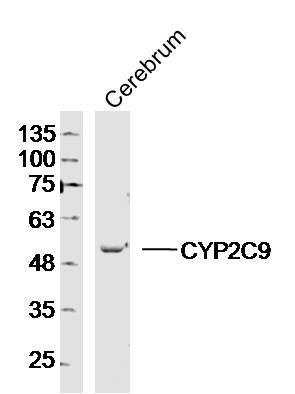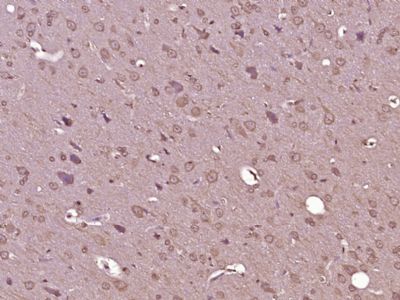微管蛋白α 1A/1B抗体
产品名称: 微管蛋白α 1A/1B抗体
英文名称: Tubulin alpha
产品编号: hz-20496R
产品价格: null
产品产地: 中国/上海
品牌商标: HZbscience
更新时间: 2023-08-17T10:24:20
使用范围: WB=1:500-2000 ELISA=1:500-1000 IHC-P=1:400-800 IHC-F=1:400-800 ICC=1:100-500 IF=1:100-500
上海沪震实业有限公司
- 联系人 : 鲍丽雯
- 地址 : 上海市闵行区闵北路88弄1-30号第22幢AQ136室
- 邮编 : 200612
- 所在区域 : 上海
- 电话 : 139****0749
- 传真 : 021-60345367
- 邮箱 : www.shzbio.net
Rabbit Anti-Tubulin alpha antibody
| 产品编号 | hz-20496R |
| 英文名称 | Tubulin alpha |
| 中文名称 | 微管蛋白α 1A/1B抗体 |
| 别 名 | TUBA1A + TUBA1B; Tubulin, Alpha 1b; Tubulin Alpha-Ubiquitous Chain; Alpha-Tubulin Ubiquitous; Tubulin K-Alpha-1; Tubulin, Alpha, Ubiquitous; Tubulin Alpha-1B Chain; Alpha Tubulin; Ubiquitous; K-ALPHA-1; Tubulin Alpha; TBA1B_HUMAN; Tubulin, Alpha 1a; TUBA3; Tubulin Alpha-3 Chain; Tubulin B-Alpha-1; LIS3; Tubulin, Alpha, Brain-Specific; Tubulin Alpha-1A Chain; Alpha-Tubulin 3, Brain-Specific; Hum-A-Tub1; Hum-A-Tub2; B-ALPHA-1; TBA1A_HUMAN; 微管蛋白alpha |
| 产品类型 | 内参抗体 |
| 研究领域 | 细胞生物 免疫学 细胞骨架 |
| 抗体来源 | Rabbit |
| 克隆类型 | Polyclonal |
| 交叉反应 | Human, Mouse, Rat, Chicken, Pig, Cow, |
| 产品应用 | WB=1:500-2000 ELISA=1:500-1000 IHC-P=1:400-800 IHC-F=1:400-800 ICC=1:100-500 IF=1:100-500 (石蜡切片需做抗原修复) not yet tested in other applications. optimal dilutions/concentrations should be determined by the end user. |
| 分 子 量 | 50kDa |
| 细胞定位 | 细胞浆 |
| 性 状 | Lyophilized or Liquid |
| 浓 度 | 1mg/ml |
| 免 疫 原 | KLH conjugated synthetic peptide derived from human TUBA1A + TUBA1B:401-451/451 |
| 亚 型 | IgG |
| 纯化方法 | affinity purified by Protein A |
| 储 存 液 | Preservative: 15mM Sodium Azide, Constituents: 1% BSA, 0.01M PBS, pH 7.4 |
| 保存条件 | Store at -20 °C for one year. Avoid repeated freeze/thaw cycles. The lyophilized antibody is stable at room temperature for at least one month and for greater than a year when kept at -20°C. When reconstituted in sterile pH 7.4 0.01M PBS or diluent of antibody the antibody is stable for at least two weeks at 2-4 °C. |
| PubMed | PubMed |
| 产品介绍 | background: Microtubules of the eukaryotic cytoskeleton perform essential and diverse functions and are composed of a heterodimer of alpha and beta tubulins. The genes encoding these microtubule constituents belong to the tubulin superfamily, which is composed of six distinct families. Genes from the alpha, beta and gamma tubulin families are found in all eukaryotes. The alpha and beta tubulins represent the major components of microtubules, while gamma tubulin plays a critical role in the nucleation of microtubule assembly. There are multiple alpha and beta tubulin genes, which are highly conserved among species. This gene encodes alpha tubulin and is highly similar to the mouse and rat Tuba1 genes. Northern blotting studies have shown that the gene expression is predominantly found in morphologically differentiated neurologic cells. This gene is one of three alpha-tubulin genes in a cluster on chromosome 12q. Mutations in this gene cause lissencephaly type 3 (LIS3) - a neurological condition characterized by microcephaly, mental retardation, and early-onset epilepsy and caused by defective neuronal migration. Alternative splicing results in multiple transcript variants encoding distinct isoforms. [provided by RefSeq, Jul 2012] Function: Tubulin is the major constituent of microtubules. It binds two moles of GTP, one at an exchangeable site on the beta chain and one at a non-exchangeable site on the alpha chain Subunit: Dimer of alpha and beta chains. A typical microtubule is a hollow water-filled tube with an outer diameter of 25 nm and an inner diameter of 15 nM. Alpha-beta heterodimers associate head-to-tail to form protofilaments running lengthwise along the microtubule wall with the beta-tubulin subunit facing the microtubule plus end conferring a structural polarity. Microtubules usually have 13 protofilaments but different protofilament numbers can be found in some organisms and specialized cells. Subcellular Location: Cytoplasm, cytoskeleton. Tissue Specificity: Ubiquitously expressed with highest levels in Brain, Bone, Adipocyte, and Breast Post-translational modifications: Undergoes a tyrosination/detyrosination cycle, the cyclic removal and re-addition of a C-terminal tyrosine residue by the enzymes tubulin tyrosine carboxypeptidase (TTCP) and tubulin tyrosine ligase (TTL), respectively. Some glutamate residues at the C-terminus are polyglutamylated. This modification occurs exclusively on glutamate residues and results in polyglutamate chains on the gamma-carboxyl group. Also monoglycylated but not polyglycylated due to the absence of functional TTLL10 in human. Monoglycylation is mainly limited to tubulin incorporated into axonemes (cilia and flagella) whereas glutamylation is prevalent in neuronal cells, centrioles, axonemes, and the mitotic spindle. Both modifications can coexist on the same protein on adjacent residues, and lowering glycylation levels increases polyglutamylation, and reciprocally. The precise function of such modifications is still unclear but they regulate the assembly and dynamics of axonemal microtubules (Probable). Acetylation of alpha chains at Lys-40 stabilizes microtubules and affects affinity and processivity of microtubule motors. This modification has a role in multiple cellular functions, ranging from cell motility, cell cycle progression or cell differentiation to intracellular trafficking and signaling (By similarity). Similarity: Belongs to the tubulin family. SWISS: Q71U36 Gene ID: 7846 Database links: TUBA1A: Entrez Gene: 7846 Human Entrez Gene: 22142 Mouse Entrez Gene: 64158 Rat Omim: 602529 Human SwissProt: Q71U36 Human SwissProt: P68369 Mouse SwissProt: P68370 Rat Unigene: 654422 Human Unigene: 405359 Mouse Unigene: 234326 Rat
TUBA1B: Entrez Gene: 10376 Human Entrez Gene: 22143 Mouse Entrez Gene: 500929 Rat Omim: 602530 Human SwissProt: P68363 Human SwissProt: P05213 Mouse SwissProt: Q6P9V9 Rat Unigene: 524390 Human Unigene: 392113 Mouse Unigene: 99661 Rat Important Note: This product as supplied is intended for research use only, not for use in human, therapeutic or diagnostic applications. |
| 产品图片 |
 Sample: Cerebrum (Mouse)Lysate at 40 ug
Primary: Anti-TUBA1A + TUBA1B(bs-20496R)at 1/300 dilution Secondary: IRDye800CW Goat Anti-RabbitIgG at 1/20000 dilution Predicted band size: 50kD Observed band size: 50kD  Paraformaldehyde-fixed, paraffin embedded (Rat brain); Antigen retrieval by boiling in sodium citrate buffer (pH6.0) for 15min; Block endogenous peroxidase by 3% hydrogen peroxide for 20 minutes; Blocking buffer (normal goat serum) at 37°C for 30min; Antibody incubation with (Tubulin alpha) Polyclonal Antibody, Unconjugated (bs-20496R) at 1:400 overnight at 4°C, followed by operating according to SP Kit(Rabbit) (sp-0023) instructionsand DAB staining
|
